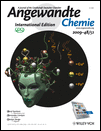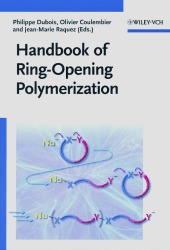Journal list menu
Export Citations
Download PDFs
Cover Picture
Cover Picture: Templated Ligand Environments for the Selective Incorporation of Different Metals into DNA (Angew. Chem. Int. Ed. 52/2009)
- Page: 9757
- First Published: 15 December 2009

DNA can template the formation of different ligand environments that are selective for their binding metals. H. F. Sleiman and co-workers describe in their Communication on page 9919 ff. how placement of a metal in the incorrect DNA-templated environment results in the occurrence of “error-checking”: the metal can spontaneously adjust its redox state, displace another labile metal to form a more-stable complex, or reorganize the coordination site to create a more-favored complex.
Inside Cover
Inside Cover: Surface Passivation and Transfer Doping of Silicon Nanowires (Angew. Chem. Int. Ed. 52/2009)
- Page: 9758
- First Published: 15 December 2009

The large surface-to-volume ratio of nanomaterials could facilitate efficient doping using purely surface passivation and adsorption. In their Communication on page 9896 ff., R. Q. Zhang, S. T. Lee, and co-workers describe surface passivation and transfer doping in silicon nanowires (SiNWs, see picture) by surface termination with hydrogen atoms and adsorption of ammonia molecules. The approach is an alternative to conventional volume doping to modulate the conductivity of SiNWs or other nanomaterials.
Graphical Abstract
Graphical Abstract: Angew. Chem. Int. Ed. 52/2009
- Pages: 9761-9773
- First Published: 15 December 2009
Corrigenda
Production of the Antifungal Isochromanone Ajudazols A and B in Chondromyces crocatus Cm c5: Biosynthetic Machinery and Cytochrome P450 Modifications†
- Page: 9773
- First Published: 15 December 2009
Snapshots of the AlAl σ-Bond Formation Starting from {AlR2} Units: Experimental and Computational Observations†
- Page: 9773
- First Published: 15 December 2009
News
Spotlights on our sister journals: Angew. Chem. Int. Ed. 52/2009
- Pages: 9774-9776
- First Published: 15 December 2009
Author Profile
News
Organic Chemistry: S. V. Ley Awarded / Nanosciences: E. Nakamura Honored / Biophysics: Prize for S. W. Hell
- Page: 9779
- First Published: 15 December 2009
Book Review
Handbook of Ring-Opening Polymerization. Edited by Philippe Dubois, Olivier Coulembier and Jean-Marie Raquez.
- Page: 9780
- First Published: 15 December 2009
Highlights
Catalyst Design
Linear Energy Relations and the Computational Design of Selective Hydrogenation/Dehydrogenation Catalysts†
- Pages: 9782-9784
- First Published: 15 December 2009

Mind over matter: Electronic structure calculations have been used to establish linear energy relations for chemical reactions on solid surfaces which aid in the design of new catalytic materials. Newly discovered accurate linear relations for the hydrogenation of organic molecules on transition metals suggest that the computational design of selective hydrogenation catalysts for complex reactions may soon be feasible.
Catalysis with Light
Review
CH Functionalization
Transition-Metal-Catalyzed Direct Arylation of (Hetero)Arenes by CH Bond Cleavage
- Pages: 9792-9826
- First Published: 15 December 2009

Cutting across: Direct arylations are increasingly viable alternatives to conventional cross-coupling reactions with stoichiometric amounts of organometallic reagents (see Scheme). This Review summarizes recent progress in the rapidly evolving research area of transition-metal-catalyzed CH bond-cleavage reactions for (hetero)aryl syntheses.
Communications
Chemical Shifts
Direct Assessment of Electron Delocalization Using NMR Chemical Shifts†
- Pages: 9828-9833
- First Published: 15 December 2009

Probe it: The new BLW-IGLO approach evaluates the magnetic responses of molecules in which conjugative interactions are “disabled” (see picture, red bonds). The NMR spectroscopy parameters of the localized structures provide ideal non-aromatic olefinic hydrogen δ(1H) references for the fully conjugated systems.
Asymmetric Catalysis
Asymmetric Organocatalytic Relay Cascades: Catalyst-Controlled Stereoisomer Selection in the Synthesis of Functionalized Cyclohexanes†
- Pages: 9834-9838
- First Published: 15 December 2009

Passing the baton: A relay cascade process provides cyclohexanes in a direct, efficient, and stereoselective manner. The triple-cascade reaction is efficient, affords high selectivities, and has a broad scope, and different diastereomers are readily accessible by judicious choice of organocatalysts.
CO2 Reduction
Non-Metal-Mediated Homogeneous Hydrogenation of CO2 to CH3OH†
- Pages: 9839-9843
- First Published: 15 December 2009

Turning a problem to advantage: CO2, a contributor to global warming, was converted into the valuable resource CH3OH by adding it to 2,2,6,6-tetramethylpiperidine and B(C6F5)3 in toluene under H2 (1–2 atm), heating the mixture at 160 °C, and vacuum distillation. CH3OH was formed via the complex shown (C blue, N purple, O red, B orange, F green) as the sole C1 product.
Main-Group Chemistry
Abnormal Reactivity of an N-Heterocyclic Carbene (NHC) with a Phosphaalkene: A Route to a 4-Phosphino-Substituted NHC†
- Pages: 9844-9847
- First Published: 15 December 2009

A naughty NHC: A stable N-heterocyclic carbene (NHC) reacts with a phosphaalkene not at the expected 2-position, but through the 4-position, which leads to an unprecedented 4-phosphino-substituted NHC that functions as a novel bifunctional ligand for gold(I). The mechanism of this reaction has been investigated using density functional calculations.
Organocatalysis
anti-Selective Asymmetric Michael Reactions of Aldehydes and Nitroolefins Catalyzed by a Primary Amine/Thiourea†
- Pages: 9848-9852
- First Published: 15 December 2009

It′s finally here: Highly anti-selective Michael reactions of a functionalized aldehyde with nitroolefins have been realized using a primary amine/thiourea catalyst (see scheme; TBS=tert-butyldimethylsilyl). The reaction relies on a conformational strategy based on directing the formation of a Z-configured enamine intermediate.
Cyclobutadiene Hopping
Photo–Thermal Haptotropism in Cyclopentadienylcobalt Complexes of Linear Phenylenes: Intercyclobutadiene Metal Migration†
- Pages: 9853-9857
- First Published: 15 December 2009

The CpCo-shuffle: {CpCo} complexes of linear [3]- and [5]phenylene undergo a light-induced haptotropic migration from a more strongly bound cyclobutadiene moiety to a less strongly bound (see scheme). The shift is thermally reversible and proceeds along the periphery of the intervening arene rings. As such, the systems constitute photo–thermal storage systems, as well the first examples of cyclobutadiene-to-cyclobutadiene haptotropism.
Fluorinated Alkenes
Highly Stereoselective Synthesis of Monofluoroalkenes from α-Fluorosulfoximines and Nitrones†
- Pages: 9858-9861
- First Published: 15 December 2009

A fine fusion: α-fluorosulfoximines readily react with simple nitrones to give monofluoroalkenes with excellent E/Z stereocontrol (see scheme). This novel fluoroolefination method shows promising applications in medicinal chemistry as monofluoroalkenes are potential mimetics for peptide units as protein inhibitors.
Immunoassay
Phospholipid-Coated Carbon Nanotubes as Sensitive Electrochemical Labels with Controlled-Assembly-Mediated Signal Transduction for Magnetic Separation Immunoassay†
- Pages: 9862-9866
- First Published: 15 December 2009
Drug Delivery
Externally Triggered Glass Transition Switch for Localized On-Demand Drug Delivery†
- Pages: 9867-9870
- First Published: 15 December 2009

I want a new drug dose: External on-demand laser triggering is used in a drug-delivery concept, with on/off ratios in excess of 1000/1. The switching mechanism involves the glass transition of hydrophobic polymers with a large change in diffusivity. Formation of a glassy surface layer of the implant in the off state plays a key role, resulting in negligible off-release. (Picture: data points indicate ibuprofen concentration).
Polymerization
Metalloorganic Polymerization Catalysis as a Tool To Probe Crystallization Properties of Polymers: The Case of Isotactic Poly(1-butene)†
- Pages: 9871-9874
- First Published: 15 December 2009

Age shall not weary them: Stereodefective isotactic polybutene samples, synthesized with single-center metallocene catalysts, crystallize from the melt into the stable form I (see picture) and do not undergo phase transformation upon aging at room temperature. Hence, the corresponding physical and mechanical properties of molded objects are not altered by aging.
Asymmetric Catalysis
Intramolecular Alkynylcyclopropanation of Olefins Catalyzed by Bi(OTf)3: Stereoselective Synthesis of 1-Alkynyl-3-azabicyclo[3.1.0]hexanes†
- Pages: 9875-9878
- First Published: 15 December 2009
![Intramolecular Alkynylcyclopropanation of Olefins Catalyzed by Bi(OTf)3: Stereoselective Synthesis of 1-Alkynyl-3-azabicyclo[3.1.0]hexanes](/cms/asset/e7179201-fa2f-475e-bc34-d2427251adba/mcontent.jpg)
The postman always rings twice: 1-Alkynyl-3-azabicyclo[3.1.0]hexanes 2 were obtained in good to excellent yields from the stereoselective Bi(OTf)3-catalyzed dehydrative alkynylcyclopropanation of azaenynols 1, in which the propargyl alcohol motif of 1 acted as a propargyl carbene synthetic equivalent.
Click Chemistry
Analysis and Optimization of Copper-Catalyzed Azide–Alkyne Cycloaddition for Bioconjugation†
- Pages: 9879-9883
- First Published: 15 December 2009

How to click with biomolecules: Copper-catalyzed azide–alkyne cycloaddition has been optimized for use with biological molecules. The key development is the addition of two reagents that allow ascorbate to be used as reducing agent whilst eliminating problems caused by copper ascorbate side reactions. The result is a robust, rapid, and convenient procedure for the modification of proteins, DNA, RNA, and other biomolecules (see scheme).
Zeolites
Diversification of RTH-Type Zeolite and Its Catalytic Application†
- Pages: 9884-9887
- First Published: 15 December 2009

The RTH-type zeolite (see picture) has an attractive pore structure, but its compositional variation is limited. Now, metallosilicates with the RTH-topology can be synthesized by two routes, one of which does not use structure-directing agents. Thus prepared Al-containing RTH-type zeolites exhibited a remarkable catalytic performance for the methanol-to-olefins reaction, producing propene with high selectivity.
Amine Synthesis
Efficient Catalytic Synthesis of Tertiary and Secondary Amines from Alcohols and Urea†
- Pages: 9888-9891
- First Published: 15 December 2009
σ-Acceptor Ligands
Gold–Silane and Gold–Stannane Complexes: Saturated Molecules as σ-Acceptor Ligands†
- Pages: 9892-9895
- First Published: 15 December 2009
Passivation Doping
Surface Passivation and Transfer Doping of Silicon Nanowires†
- Pages: 9896-9900
- First Published: 15 December 2009

Staying on top: Altering the surface of silicon nanowires (SiNWs) by terminating the surface with different species and/or introducing surface adsorbates can change the electrical properties of the SiNWs. Such easy, nondestructive conductivity modification would expand possible applications of SiNWs.
Coordination Polymers
Iodinated Nanoscale Coordination Polymers as Potential Contrast Agents for Computed Tomography†
- Pages: 9901-9904
- First Published: 15 December 2009

Nanoscale coordination polymers (NCPs), prepared with metal ions and an iodinated ligand, were synthesized using reverse-phase microemulsion techniques and rapid precipitation procedures. The NCPs carry high payloads of iodine (ca. 63 wt %) and have potential applications as a new class of contrast agents for computed tomography (CT), as demonstrated by phantom studies (see figure).
Metal–Organic Frameworks
Freeze Drying Significantly Increases Permanent Porosity and Hydrogen Uptake in 4,4-Connected Metal–Organic Frameworks†
- Pages: 9905-9908
- First Published: 15 December 2009

Freeze the flood: After replacing high boiling-point solvents inside the channels of a metal–organic framework (MOF), benzene is frozen and then removed under vacuum by sublimation. Bypassing the liquid phase eliminates the detrimental effects of surface tension that induce mesopore collapse in MOFs, thereby enhancing their permanent porosity and hydrogen-uptake capacity (see scheme).
Nanostructures
Photoresponsive Supramolecular Organometallic Nanosheets Induced by PtII⋅⋅⋅PtII and CH⋅⋅⋅π Interactions†
- Pages: 9909-9913
- First Published: 15 December 2009

It's a flat world: Charge-neutral pincer-type cyclometalated platinum(II) aryl acetylides can be assembled into quasi-two-dimensional nanosheets through bilateral intermolecular noncovalent interactions (see picture). These nanosheets can be further self-organized into layered materials on a flat substrate and exhibit NIR phosphorescence and light-modulated conductivity.
Drug Delivery
Reversibly Stabilized Multifunctional Dextran Nanoparticles Efficiently Deliver Doxorubicin into the Nuclei of Cancer Cells†
- Pages: 9914-9918
- First Published: 15 December 2009

Getting in there: Efficient intracellular delivery of anticancer drugs is achieved by using reversibly cross-linked dextran nanoparticles, which are rapidly destabilized under reductive environments that mimic those of the intracellular compartments. These nanoparticles show high drug loading efficiency and reduction-triggered release of doxorubicin in vitro as well as inside tumor cells, particularly to the cell nucleus (see scheme).
Metal–DNA Structures
Templated Ligand Environments for the Selective Incorporation of Different Metals into DNA†
- Pages: 9919-9923
- First Published: 15 December 2009

Each to his own: DNA templates the formation of bis(terpyridine), bis(phenanthroline), and terpyridine:phenanthroline ligand environments, which strongly bind FeII, CuI, and CuII (see picture), respectively, to generate highly stable metal–DNA complexes. When a metal is placed in the “incorrect” environment, it can spontaneously adjust its redox state, be displaced by another metal, or reorganize the coordination site to create a more favored complex.
Photothermal Effect
Probing the Photothermal Effect of Gold-Based Nanocages with Surface-Enhanced Raman Scattering (SERS)†
- Pages: 9924-9927
- First Published: 15 December 2009

A spectral thermometer: The conformation of molecules on a metallic nanoparticle's surface is sensitive to temperature variations and can be easily monitored in situ by surface-enhanced Raman scattering (SERS). Excitation of the metallic nanoparticle for SERS can concurrently induce a photothermal effect whereby the light absorbed by the nanoparticle is released as heat. From the SERS spectra, the changes in temperature during the photothermal effect can be derived (see picture).
Magnetism
A Calix[4]arene 3d/4f Magnetic Cooler†
- Pages: 9928-9931
- First Published: 15 December 2009
![A Calix[4]arene 3d/4f Magnetic Cooler](/cms/asset/29ce22a1-587c-4115-a5a3-12e60428ec70/mcontent.jpg)
Chilling out: The first 3d/4f cluster based on calix[4]arenes (see picture; purple Mn, brown Gd, red O, blue N) has a high magnetic isotropy and a large number of molecular spin states that are populated even at low temperatures, whereas its ferromagnetic limit is approached only at high applied fields. These results enable the complex to be an excellent magnetic refrigerant for low-temperature applications.
Localized SERS
Direct Evidence of High Spatial Localization of Hot Spots in Surface-Enhanced Raman Scattering†
- Pages: 9932-9935
- First Published: 15 December 2009

Hot and cold: The high degree of localization in SERS hot spots is demonstrated directly by a selective deposition of Raman analytes inside and outside the field-enhanced regions in a plasmonic cavity (see picture). The localization is demonstrated by measurements of both the absolute SERS intensities and the kinetics for photoinduced degradation at different positions.
Conjugated Oligomers
Pentiptycene-Derived Oligo(p-phenyleneethynylene)s: Conformational Control, Chain-Length Effects, Localization of Excitation, and Intrachain Resonance Energy Transfer†
- Pages: 9936-9939
- First Published: 15 December 2009

Do the twist: The preference of large pentiptycene–pentiptycene dihedral angles and the restricted torsional relaxation for pentiptycene-derived oligo (p-phenyleneethynylene)s in a 2-methyltetrahydrofuran glass at 80 K result in a localized excited state. These results demonstrate not only the concept of torsion-induced localization of excitation but also the efficient intrachain energy hopping processes in conjugated polymers.
Total Synthesis (1)
Total Synthesis of Spirastrellolide F Methyl Ester—Part 1: Strategic Considerations and Revised Approach to the Southern Hemisphere†
- Pages: 9940-9945
- First Published: 15 December 2009

In readiness for closure: To ensure optimal convergence in the projected total synthesis of spirastrellolide F, the building block representing the southern hemisphere was prepared with a free carboxylic acid and an enol triflate (Tf) terminus (see picture). This unusual pattern allows the 38-membered macrocyclic core of this potent antimitotic agent to be constructed, while keeping late-stage protecting-group manipulations to a minimum.
Total Synthesis (2)
Total Synthesis of Spirastrellolide F Methyl Ester—Part 2: Macrocyclization and Completion of the Synthesis†
- Pages: 9946-9950
- First Published: 15 December 2009

Marvel of the sea: A concise and highly convergent total synthesis of the methyl ester of the marine macrolide spirastrellolide F (see picture), which has exquisite antimitotic properties, is reported. In this approach, the northern and the southern hemispheres of this intricate target are stitched together in only two consecutive steps (Suzuki coupling, Yamaguchi lactonization) without any interim protecting-group manipulations.
Conductive Organic Crystals
Phosphonated Hexaphenylbenzene: A Crystalline Proton Conductor
- Pages: 9951-9953
- First Published: 15 December 2009

Well stacked: Organic crystals of small molecules constitute an alternative to common polymeric electrolytes (Nafion 117) and inorganic crystals that are employed as proton exchange membranes in fuel cell systems. A phosphonic acid containing hexaphenylbenzene forms a columnar supramolecular array and exhibits a high and constant intrinsic conductivity of 3.2×10−3 S cm−1 from 120 to 180 °C under 1 bar H2O atmosphere (see picture).
Porous Materials
A Mesoporous Metal–Organic Framework†
- Pages: 9954-9957
- First Published: 15 December 2009

MOF for more gas storage: A new mesoporous metal–organic framework (MOF) with extremely high adsorption capacities for methane, H2, and n-butane is prepared from the reaction of H3(btb), H2(2,6-ndc), and zinc nitrate (btb=benzene-1,3,5-tribenzoate; 2,6ndc=2,6-naphthalenedicarboxylate). The main structural motif is a dodecahedron formed from 12 Zn4O6+ clusters, four 2,6-ndc, and eight btb linkers (see picture; green: Zn4O6+, gray: C, red: O; the red sphere illustrates the pore volume).
Organolithium Compounds
A Dilithium 1,4-Butanediide with a Chlorine-Centered Li12 Icosahedral Structure†
- Pages: 9958-9961
- First Published: 15 December 2009
Hydrogen Generation
Light-Driven Hydrogen Generation: Efficient Iron-Based Water Reduction Catalysts†
- Pages: 9962-9965
- First Published: 15 December 2009

Let your light shine: A novel state-of-the-art system for light-driven proton reduction with iron catalysts was developed (see scheme; SR=sacrificial reagent). It consists of simple iron carbonyl complexes such as [Fe3(CO)12], triethylamine as sacrificial reagent (electron donor), and [Ir(bpy)(ppy)2]PF6 as photosensitizer (PS). High turnover numbers of more than 3000 for the sensitizer and 400 for the iron catalyst are obtained.
Molecular Wires
Single Molecular Wires Connecting Metallic and Insulating Surface Areas†
- Pages: 9966-9970
- First Published: 15 December 2009

Totally wired: A particular molecular adsorption geometry can be prepared by adsorbing single conjugated polyfluorene chains partially on a clean Au(111) surface and partially on a thin crystalline NaCl film, thus connecting metallic and insulating surface areas. This configuration allows the electronic characterization of one and the same molecular wire as a function of its atomic-scale environment in a planar configuration.
Annulenes
Is the [9]Annulene Cation a Möbius Annulene?†
- Pages: 9971-9974
- First Published: 15 December 2009
![Is the [9]Annulene Cation a Möbius Annulene?](/cms/asset/14c001ac-9e35-4f56-b486-43b4d04d9247/mcontent.jpg)
Does it do the twist? High-level theoretical calculations show that the [9]annulene cation exists in two isomers: a twisted 4n electron Möbius aromatic compound, and a non-twisted boat-like Hückel conformation (see scheme). The latter form was detected by laser flash photolysis experiments; an example of a stable, charged, or uncharged parent Möbius annulene is still elusive.
Organocatalysis
A Catalytic Asymmetric 6 π Electrocyclization: Enantioselective Synthesis of 2-Pyrazolines†
- Pages: 9975-9978
- First Published: 15 December 2009

A closer look at α,β-unsaturated hydrazonium ions reveals that they are isoelectronic to the pentadienyl anion, making them suitable substrates to undergo 6π electrocyclizations. The enantioselective catalysis of this transformation is achieved for the first time by asymmetric Brønsted acid catalysis.
Catalytic Asymmetric 6π Electrocyclization: Enantioselective Synthesis of Functionalized Indolines†
- Pages: 9979-9982
- First Published: 15 December 2009

How to close a ring: An approach to catalytic asymmetric 6π electrocyclization leads to a highly enantioselective process that was used in the synthesis of chiral indolines (see scheme). Treatment of N-aryl imines under phase transfer conditions in the presence of N-benzyl cinchonidinium chloride generates a delocalized 2-aza-pentadienyl anion system that cyclizes in up to 99 % yield and 98 % ee.















































